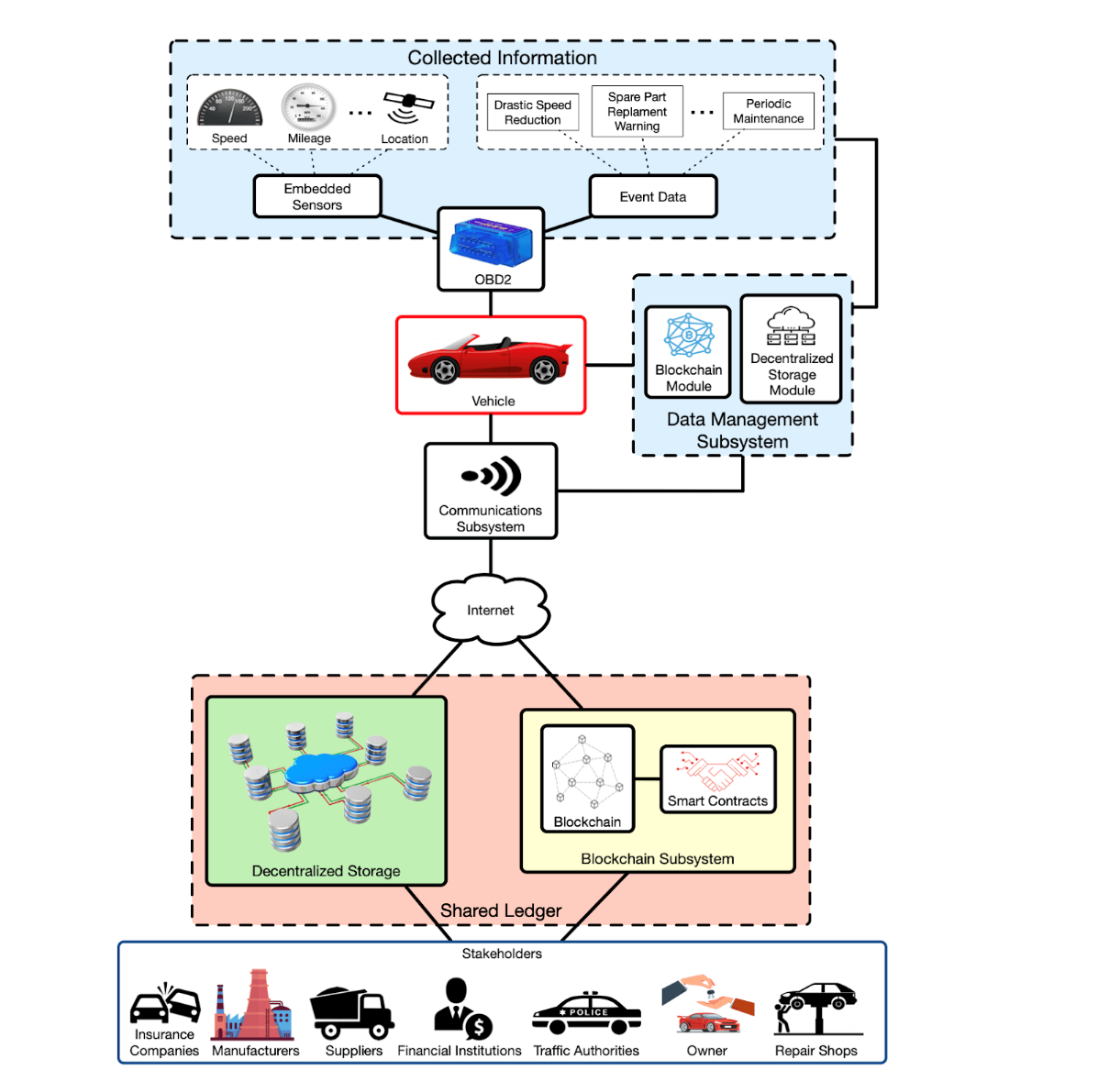Blockchain for Automotive IoT and IoT-Connected Vehicles
Written by Paula Fraga-Lamas and Tiago M. Fernández-Caramés
In the last years, Blockchain and Distributed Ledger Technologies (DLTs) have revolutionized the way many industries operate thanks to allowing non-trusted parties to perform transactions in a transparent and secure way, thus avoiding the participation of traditional intermediaries (e.g., banks, lawyers, or government agencies) and their involved fees. Such a revolution can also impact smart mobility, enabling the development of digital vehicle logbooks, enhancing smart manufacturing traceability, avoiding part counterfeiting, automating claim processing, or implementing usage-based car insurances. To emphasize the impact of blockchain and DLTs on the automotive industry, this article, after defining the basics of blockchain and DLTs, reviews the most relevant automotive blockchain-based applications and then focuses on a specific case: How blockchain can fuse with automotive Internet of Things (IoT) and IoT-connected vehicles to enable the development of a new generation of applications for vehicles that will make them smarter and safer.
Blockchain Basics for the Automotive Industry
Blockchain is a specific type of Distributed Ledger Technology (DLT) that provides secure communications, data privacy, trustworthiness, resilience, and accountability [1]. Blockchain leverages asymmetric cryptography and relies on consensus mechanisms to create a chain of linked blocks that solves the double-spending problem. Blockchain also leverages smart contracts, which are made of decentralized self-executed code that can receive data from external sources and run autonomously when certain predefined conditions are met.
Blockchain can benefit the automotive industry, which has many different internal and external stakeholders (e.g., dealers, retailers, OEMs, insurance companies, financial institutions, fleet management services or government agencies) that belong to different industries and to countries with different regulations. Such stakeholders transfer value (e.g., data, transactions, processes, workflow) across their business networks and have specific requirements related to trust, security, or time (e.g., real-time access), and to transaction and operational costs. There are several areas of the automotive industry where the use of blockchain can benefit this business network [2]:
- Immutable data management: Proof of ownership can be used to avoid identity-related frauds, to provide a car traceability history, to enhance supply chain processes, to guarantee the authenticity of car or spare parts, to protect intellectual property (i.e., patents) or to preserve audit trail data.
- Operation management: Blockchain can provide supply chain traceability of critical assets or provenance of parts.
- Financial management: Blockchain can automate and accelerate cross-border payments, automotive financing, incentives and peer-to-peer payments, insurance claims, car auctions, car maintenance or repairs.
Blockchain Applications for the Automotive Industry
The most compelling applications for the automotive industry are:
- Digital logbook of a vehicle history: A blockchain can be used for storing securely, updating, and verifying tamperproof information like vehicle maintenance or ownership history. Thus, blockchain can provide a ledger shared among the different involved and authorized entities, such as car manufacturers, car dealers or independent repair shops. Process automation can be achieved through smart contracts, which can gather information from multiple sources and then implement a payment system for accessing vehicular data. For instance, Bosch and TÜV Rheinland presented a digital logbook to verify mileage data [3]. Similarly, VerifyCar, an initiative led by BMW, proposed to equip each vehicle with a digital car pass with all its information [4]. In the case of Renault [5], they connected the car maintenance pass with its digital twin.
- Supply chain traceability: To improve business efficiency by reducing the cost for tracking critical assets, ensuring warranty, easing maintenance or recycling tasks. For example, Daimler has been particularly active in developing blockchain-based solutions, carrying out pilots for monitoring its suppliers’ working conditions [6], for tracking CO2 emissions in its cobalt supply chain [7] or for creating a blockchain hardware wallet for cars [8]. BMW has also analyzed the use of blockchain-based supply chain verification systems for manufacturing, for spare part traceability and for determining the source of certain raw materials like cobalt or tungsten that may come from mines in countries in war [4].
- Fraud prevention: Odometer frauds can be prevented by collecting, storing, and timestamping mileage data through a blockchain.
- Claim processing and insurance: A shared ledger can also be used to prove liability when an accident occurs. This application allows for simplifying and speeding up claiming and insurance processes by automatically filling a claim and then sending the information to the insurance company through a smart contract. Moreover, inputs such as braking patterns or speed can also be used to avoid fraud or to provide customized insurance fees.
- Incentives: Blockchain enables creating customized experience and reward programs.
- Mobility As a Service (MaaS) application: Blockchain technologies can support platforms and ecosystems of business models of IoT-connected vehicles, electric vehicle and smart charging services, self-driving vehicles, car-sharing, ridesharing or ride-hailing providers.
- Financial mechanisms: Peer-to-peer lending, leasing, and financing.
- Smart mobility: IoT-connected services and end-to-end integration of infrastructure and vehicles.
Automotive IoT and IoT-Connected Vehicle Use Case
Automotive IoT and IoT-connected vehicles enable monitoring and controlling devices, vehicles, and infrastructure remotely and bring insights from real-time data to manufacturers, suppliers, traffic authorities, drivers, or insurance companies. Blockchain can help to track, process and exchange transactions among IoT connected systems while overcoming the limitations of traditional approaches: centralization, lack of privacy or safety, and cybersecurity threats. Therefore, blockchain can enable the development of a new generation of applications for vehicles that will make them smarter and safer. IoT systems composed by sensors and devices connected over a mobile network will allow the data acquisition of driving events (e.g., mileage, speed, location), safety events (e.g., drastic speed reduction, spare part replacement notification, incident, or accident warning), maintenance events (e.g., periodic maintenance) and sending such data to a blockchain that is shared among the authorized stakeholders. The architecture depicted in Figure 1 shows how the vehicle collects information from the multiple embedded sensors or the Event Data Recorder (EDRs), and sends it through an on-board interface (e.g., through OBD2 (On-Board Diagnostics 2)) to a blockchain module or to a decentralized storage system like IPFS (Inter-Planetary File System) [9]. Vehicular communications can be performed through 3G/4G/5G/6G infrastructure or by making use of specific infrastructure based on IEEE 802.11p DSRC (Dedicated Short-Range Communications) or WAVE (Wireless Access in Vehicular Environments). In addition, smart contracts can be run on the blockchain to automate tasks. Authorized stakeholders can be granted access to both the blockchain and the decentralized storage, allowing them to read, store and check the authenticity of the collected information, as well as to provide novel smart services on top of it.

Figure 1: Proposed communications architecture for Blockchain applications for Automotive IoT and IoT-connected vehicles.
Conclusion
This article provided an overview of promising blockchain applications for an advanced automotive industry as well as an explanation of one of the most relevant use cases: automotive IoT and IoT-connected vehicles. Although there are several open issues regarding the maturity of the technology, which must be addressed prior to deploying blockchain and DLT applications, their capabilities can provide a trusted platform capable of managing cyber-resilient information that defies current non-collaborative organizational structures and faces some of the challenges of future mobility and complex vehicular ecosystems.
References
[1] C. Ebert, P. Louridas, T. M. Fernández-Caramés and P. Fraga-Lamas, ``Blockchain Technologies in Practice," IEEE Software, vol. 37, no. 4, pp. 17-25, July-Aug. 2020.
[2] P. Fraga-Lamas and T. M. Fernández-Caramés, ``A Review on Blockchain Technologies for an Advanced and Cyber-Resilient Automotive Industry,'' IEEE Access, vol. 7, pp. 17578-17598, Jan. 2019.
[3] Blockchain: Bosch and TÜV Rheinland Present a Solution for Odometer Fraud, March 2020, [online] Available online: https://bit.ly/2LMojCp
[4] BMW: how blockchain automotive can help drivers. Available online: https://bit.ly/2UdxxKA
[5] Renault creates the first digital car maintenance book. Available online: https://bit.ly/2LXNUre
[6] Daimler work on blockchain. Available online: https://bit.ly/3ae8TPk
[7] Mercedes-Benz pilot project on tracking CO2 in the cobalt supply chain. Available online: https://bit.ly/2y1UbNi
[8] Business Insider on Daimler’s blockchain hardware wallet. Available online: https://bit.ly/2wuEYE0
[9] Inter-Planetary File System official webpage. Available online: https://ipfs.io
This article was edited by Sara Paiva
To view all articles in this issue, please go to November 2021 eNewsletter. For a downloadable copy, please visit the IEEE Smart Cities Resource Center.


To have the eNewsletter delivered monthly to your inbox, join the IEEE Smart Cities Community.
Past Issues
To view archived articles, and issues, which deliver rich insight into the forces shaping the future of the smart cities. Older eNewsletter can be found here. To download full issues, visit the publications section of the IEEE Smart Cities Resource Center.



